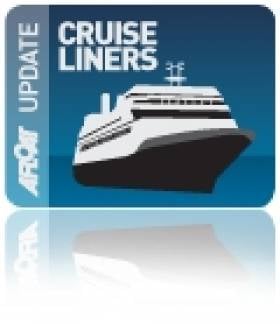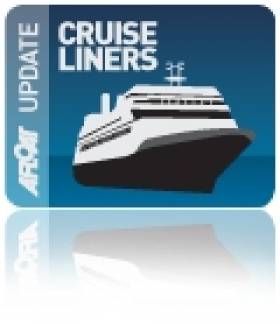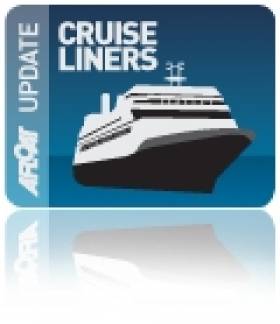Displaying items by tag: Cunard Line
Cruiseship Calls to Dublin Includes Ship-to-Ship Refuelling
Some six hours previously Swan Hellenic's sleek Minerva (1996/12,500grt) picked up a pilot off Dalkey after sailing overnight from Portsmouth. She was followed astern by Saga Cruises Saga Ruby (1973/24,292grt) from Dover and likewise she too picked up a pilot close to the South Burford bouy. Incidentally Minerva had operated for Saga Cruises as their Saga Pearl but in recent years she has returned to her original name.
The classic lines of Saga Ruby are attributed to her combined ocean liner/cruiseship design when launched Vistafjord in 1973. The vessel was built by Swan Hunter Shipbuilders for Norwegian America Line. A decade later she was sold to Cunard Line who retained her original name until 1999 when she became the third Caronia. To read more about this former 'Cunarder' click HERE and how her interior looks now click HERE.
Dawn Princess departed Dublin this mid-afternoon bound for Cobh. Minerva is to due to leave around midnight while Saga Ruby remains overnight, in fact her call is particularly leisurely as she does set sail from the capital until tea-time tomorrow.
- Dublin Port
- Cobh
- Cruise Liners
- bunkers
- dalkey
- Princess Cruises
- Cobh Cruise Terminal
- Cruiseships
- Port of Dublin
- Ports and Shipping News
- Ocean Pier
- Cunard Line
- Cruiseliners
- Saga Cruises
- Saga Ruby
- Caronia
- Cruise Liners news
- Cruise ships
- Swan Hellenic Cruises
- Dawn Princess
- Minerva
- Refueling
- Dublin Cruiseships
- Dublin cruisecalls
- Saga Pearl
- Coastal tanker
- South Burford bouy
- Cunarder
Floating City Hotel to Mark Start of Islands Cruise
Passengers embarking in Dublin Port for a cruise next month will firstly spend their first night onboard while docked in the capital, writes Jehan Ashmore.
The classic cruiseship Saga Ruby will welcome her passengers and after checking in they can explore the 4-star rated vessel followed by dinner, marking the first evening of an eight-night cruise of the Faroe, Orkney & Outer Hebridean Islands.
On the following day passengers can remain onboard and enjoy the facilities or take an optional tour of Dublin or Wicklow prior to returning to the cruiseship for the evening departure on 24 July.
Prices start from €1,159pp in a twin inside cabin, for more information on other cabin categories and the cruise from John Galligan Travel click here.
Saga Ruby is one of the last traditionally built cruiseships, featuring spacious wooden decks in particularly on the tiered decks overlooking her cruiser stern. The 24,492 tonnes vessel joined Saga Cruises in 2005 after a $17m refit and was at one stage was the Caronia of Cunard Line, but she started her career as Vistafjord for Norwegian America Line as a combined cruise-liner /cruise-ship when built in 1973. To read more about the classic ship click here.
She can take over 600 passengers and is currently operated by the Saga Cruises which caters primarily for the UK over-50's market noting passengers can be accompanied by adults over 40.
Cork's Cruiseship's Call Schedule 2011
The inaugural call for this season was made last Monday by Cunard Line's Queen Victoria (90,049grt) and the four year-old vessel is to return for another visit on 5 May. Her slighty larger sister Queen Elizabeth (90,400grt) will make her maiden 'Irish' port of call on 10 September.
Last Autumn the 2,092 passenger cruiseship newbuild was 'floated-out' of the building dry-dock at Fincantieri's Monfalcone shipyard in Italy. At 294m long her hull is derived from the 'Vista' class series built for Carnival Corporation, owners of the Cunard Line.
Four days later the Cunard 'flagship' Queen Mary 2 (QM2) will also make an appearance. The 148,528grt French built vessel is the only designated cruise-liner in the world, the title was handed on from her predecessor, Queen Elizabeth II (QE2).
Throughout the career of the iconic liner, she made several calls to Cork (Ringaskiddy) while employed on the Atlantic 'liner' service between Southampton and New York.
On her farewell cruise QE2 made her first and only call to Cobh in 2008, the 70,327grt ship was meant to stay for a standard day-long visit but due to strong windy weather conditions in Cherbourg, she was prevented from docking and spent an un-scheduled overnight stay in the picturesque location.
The scheduling of all three 'Cunarders' to Cobh will be a first for the Port of Cork. Asides the Italian-built trio, there will be plenty more cruise callers lined up for the season, notably the Independence of the Seas, the largest cruiseship caller to an Irish port.
The Finnish built giant weighs 154,407 grt (some 6,000 tonnes larger than the liner QM2) and can carry 4,375 passengers.
Another large visitor will be the Azura at 115,055grt which can handle 3,100 passengers. She is the built to a design based from the 'Grand' class ships commissioned for Carnival Corporation's which also owns Princess Cruises.
The value of the cruiseship sector business to the island of Ireland this year is valued at €60m. The list below is a schedule of cruiseship calls to Cork Harbour (Cobh, Ringaskiddy and Cork city-centre quays).
Please note information is based in the order of ship's name first, passenger capacity (PAX), arrival date (time), location of berth and lastly departure date (time). For the most up-to-date information please refer to the Port of Cork Company website cruise call list.
ATHENA 580 Apr 27th at 08:00 Cobh Cruise Terminal
CELEBRITY ECLIPSE 3129 Apr 30th at 14:00 Cobh Cruise Terminal
May 1st at 16:00
INDEPENDENCE OF THE SEAS 4375 May 1st at 17:00 Cobh Cruise Terminal
May 2nd at 18:00
CELEBRITY ECLIPSE 3129 May 4th at 14:00 Cobh Cruise Terminal
DISCOVERY 689 May 4th at 07:00 Ringaskiddy DWB May 4th at 22:00
QUEEN VICTORIA 2000 May 5th at 20:02 Cobh Cruise Terminal
May 25th at 18:00
EMERALD PRINCESS 3592 May 6th at 08:00 Cobh Cruise Terminal
May 6th at 19:00
LE BOREAL 260 May 9th at 07:00 Cobh Cruise Terminal May 9th at 17:00
GRAND PRINCESS 3300 May 15th at 06:00 Cobh Cruise Terminal
May 15th at 17:00
COSTA DELIZIOSA 2826 May 17th at 07:00 Cobh Cruise Terminal
May 17th at 19:00
CROWN PRINCESS 3114 May 24th at 07:00 Cobh Cruise Terminal
May 24th at 17:00
ROTTERDAM 1668 May 26th at 07:00 Cobh Cruise Terminal
May 26th at 17:00
SILVER WHISPER 1668 May 28th at 09:00 Cobh Cruise Terminal
May 28th at 23:00
LE DIAMANT 200 Jun 22nd at 06:00 Cobh Cruise Terminal
Jun 22nd at 19:00
ASTOR 656 Jun 27th at 06:00 Ringaskiddy DWB
SILVER CLOUD 296 Jun 27th at 07:00 Cobh Cruise Terminal
Jun 27th at 19:00
MINERVA 352 Jul 1st at 07:00 Cobh Cruise Terminal
LE DIAMANT 200 Jul 7th at 06:00 North Custom House Quay
Jul 7th at 23:30
AURORA 1950 Jul 7th at 11:30 Cobh Cruise Terminal
Jul 7th at 23:00
ATHENA 580 Jul 15th at 08:00 Cobh Cruise Terminal
Jul 15th at 17:00
SILVER CLOUD 296 Jul 18th at 07:00 Cobh Cruise Terminal
Jul 18th at 19:00
SPIRIT OF ADVENTURE 470 Jul 19th at 06:00 North Custom House Quay
Jul 19th at 18:00
ROTTERDAM 1668 Jul 19th at 07:00 Cobh Cruise Terminal
Jul 19th at 17:00
AZURA 3100 Jul 19th at 08:00 Ringaskiddy DWB
Jul 19th at 18:00
DAWN PRINCESS 2342 Jul 24th at 06:00 Cobh Cruise Terminal
Jul 24th at 17:00
CROWN PRINCESS 3114 Jul 26th at 07:00 Cobh Cruise Terminal
Jul 26th at 17:00
MARINA- Jul 27th at 07:00 Cobh Cruise Terminal
Jul 27th at 18:00
AIDABLU 2580 Aug 11th at 07:00 Cobh Cruise Terminal
Aug 11th at 18:00
MAASDAM 1613 Aug 13th at 06:00 Cobh Cruise Terminal
Aug 13th at 15:00
SEVEN SEAS VOYAGER 730 Aug 17th at 07:00 Cobh Cruise Terminal
Aug 17th at 15:00
CROWN PRINCESS 3114 Aug 18th at 07:00 Cobh Cruise Terminal
Aug 18th at 17:00
LE DIAMANT 200 Aug 19th at 06:00 Cobh Cruise Terminal
Aug 19th at 23:30
CLIPPER ODYSSEY 128 Aug 19th at 07:00 Cobh Cruise Terminal
Aug 19th at 21:00
ATHENA 580 Aug 22nd at 07:30 Cobh Cruise Terminal
Aug 22nd at 17:00
AIDABLU 2580 Aug 25th at 07:00 Cobh Cruise Terminal
Aug 25th at 18:00
LE DIAMANT 200 Aug 26th at 06:00 Cobh Cruise Terminal
Aug 26th at 23:00
ARCADIA 2388 Aug 29th at 07:00 Cobh Cruise Terminal
Aug 29th at 17:00
AZAMARA JOURNEY 702 Aug 31st at 08:00 Cobh Cruise Terminal
COSTA DELIZIOSA 2826 Sep 1st at 07:00 Cobh Cruise Terminal
Sep 1st at 18:00
LE DIAMANT 200 Sep 3rd at 07:00 North Custom House Quay
Sep 3rd at 17:00
PRINSENDAM 843 Sep 3rd at 09:00 Cobh Cruise Terminal
Sep 3rd at 18:00
DISCOVERY 689 Sep 4th at 08:00 Cobh Cruise Terminal
Sep 4th at 18:00
SILVER CLOUD 296 Sep 5th at 07:00 Cobh Cruise Terminal
Sep 5th at 18:00
JEWEL OF THE SEAS 2500 Sep 6th at 08:00 Cobh Cruise Terminal
Sep 6th at 16:00
SILVER WHISPER 388 Sep 10th at 06:00 Cobh Cruise Terminal
Sep 10th at 18:00
QUEEN ELIZABETH 2092 Sep 10th at 08:00 Ringaskiddy DWB
Sep 10th at 17:00
OCEAN COUNTESS 884 Sep 14th at 06:30 Ringaskiddy DWB
Sep 14th at 16:30
QUEEN MARY 2 2592 Sep 14th at 08:00 Cobh Cruise Terminal
Sep 14th at 17:00
OCEAN COUNTESS 884 Sep 16th at 07:30 Cobh Cruise Terminal
FRAM 500 Sep 28th at 07:00 Cobh Cruise Terminal
Sep 28th at 18:00
SAGA RUBY 668 Dec 15th at 07:00 Cobh Cruise Terminal
Dec 15th at 23:00
- Cruiseships
- Cruise Liners
- Cork Harbour
- Cork Harbour News
- Port of Cork Company
- Port of Cork News
- Cobh
- Cobh Cruise Terminal
- Cunard Line
- Carnival Corporation
- Princess Cruises
- queen victoria
- Queen Elizabeth
- Queen Elizabeth II
- QE2
- Queen Mary 2
- QM2
- Independence of the Seas
- Royal Carribean Cruise Line
- RCCL
- Fincantieri
- Grandclass
- Vistaclass
- Ports and Shipping News
Former WW II Oil-Tanker Lays Cables Across Cork Harbour
To read further information about the cable installation project which is listed on the Port of Cork Company website under Notice to Mariners (No. 6 of 2011) click here.
The odd appearance of the barge masks a colourful and chequered career, as only a remnant of the original vessel survives (see photo). Only the forward section and bow (90m long X 20m beam) remain after the partial scrapping of the former oil tanker, Esso København, which took place nearly fifty years ago.
She was launched in 1930 as the MS Peter Hurll by the Palmers Shipbuilding and Iron Company Ltd (Yard/Hull no. 479) at Hebburn-on-Tyne, England. Measuring 11,952grt the tanker was commissioned for Baltisch-Amerik Petroleum Import G.m.b.H. (Waried Tankschiff Rhed.) of Danzig. For further details click here.
The vessel's profile was typical of the era, with a 'two-island' arrangement where the bridge superstructure is sited amidships and separated from the crew's accommodation quarters located aft on the poop deck at the stern.
At 452-foot long, the 17,585dwt vessel had a cargo carrying capacity of 138,108 barrels, which had an assigned pumping rate of 4,000 barrels an hour. The twin-screw diesel powered vessel had 5,300 brake horsepower engines that gave a speed of 12.3 knots.
In 1935 the vessel was sold to the Panama Transport Co. of Panama. While en route to Aruba, with an American crew, war was declared in Europe on September 3, 1939. At the Caribbean island's port of Las Piedras the Peter Hurll loaded her first war-time cargo of 106,514 barrels of fuel and crude oils bound for Everett, Mass.
Throughout the war years the Peter Hurll was crewed at various times between Americans and Danes. To read in greater detail the career history of the vessel and an account of the attempted U-Boat attack on the Peter Hurll click here. The tanker had several sisters, the F. H. Bedford Jr, J. H. Senior, J.A. Mowinckel and The Heinrich v. Riedemann which was lost on April 16, 1942.
Only a few months after the war in February 1946, the Peter Hurll bunkered the Queen Mary, which was moored alongside Pier 90 on the North River, New York. In less than 10 hours the vessel tranferred 27,797 barrels of fuel in a direct tanker-to-ship delivery of fuel oil. The famous 80,000 tonnes Cunard liner which like the tanker, was also built in 1930, had been recently re-converted from a troopship to her peacetime role as a passenger-liner.
In 1967 the liner retired and the vessel is moored at Long Beach, California, as a static hotel, restaurant and museum (see www.queenmary.com).
Two years later the Peter Hurll changed ownership to Det Danske Petroleums A/S of Copenhagen but later under the control of Dansk Esso A/S was renamed Esso København (see link) and the vessel was enlarged to a tonnage of 12,043grt.
In 1952, the vessel was taken to Odense, Denmark by H. J. Hansen, where the vessel was partially broken-up. The remaining fore-end survived and was rebuilt as a cable / pipe laying barge in 1963 (click here). The structure which essentially is a barge was named Henry P Lading for new owners, Nordisk Kabel og Traadfabrikker A/S, Copenhagen.
At one stage the barge was renamed "Nkt Cables a/S" but in 2002 the barge was sold to Jydsk Dykkerfirma ApS, now named JD Contractor A/S. The company (click here) is the largest underwater contractor in Denmark, providing diving assignments and the laying and embedding of submarine cables and pipelines worldwide.
Only late last year, scuba-divers found a fully intact World War I U-Boat on the seabed just outside Cork harbour. To read more about the U-Boat which sank some 93 years ago and photos click here.
































































